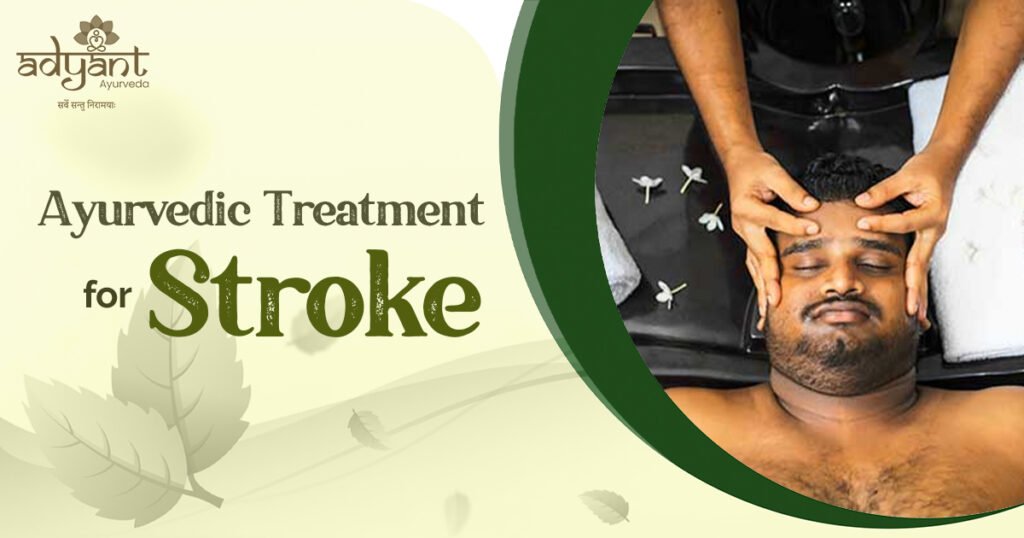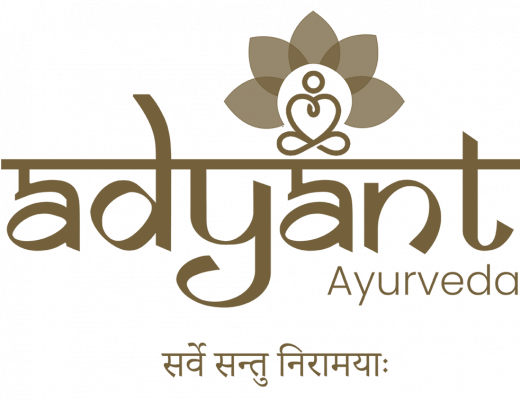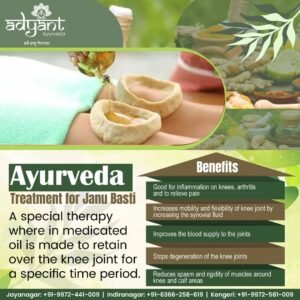Introduction
The traditional Indian medical system of Ayurveda uses a holistic approach to treat a variety of illnesses, including stroke. A stroke is a serious medical emergency that happens when the blood supply to the brain is cut off. Haemorrhagic stroke and ischemic stroke are the two primary subtypes of stroke. Ayurveda offers safe, effective treatments for stroke that promote balance restoration and general health. We will examine Ayurvedic treatments for both types of strokes in this blog post, as well as the offerings of one of the top Ayurvedic clinics, Adyant Ayurveda.
Understanding Stroke: Ischemic and Hemorrhagic
A stroke happens when the blood supply to the brain is suddenly cut off, depriving brain cells of oxygen and nutrition. The most frequent type of stroke is an ischemic stroke, which is brought on by a blood clot blocking a brain-supplying artery. On the other hand, a ruptured blood artery that causes bleeding in or near the brain causes a haemorrhagic stroke.
Ischemic Stroke Symptoms:
- Sudden weakness or numbness on one side of the face, arm, or leg, often affecting just one side of the body.
- Difficulty speaking or understanding speech. The person may have slurred speech or struggle to find the right words.
- Trouble with vision, such as blurred or double vision, or sudden loss of vision in one or both eyes.
- Sudden and severe headache with no apparent cause.
- Dizziness, loss of balance, or difficulty walking.
Hemorrhagic Stroke Symptoms:
- Sudden and severe headache, often described as the worst headache of one’s life.
- Nausea and vomiting.
- Weakness or numbness on one side of the body.
- Difficulty speaking, understanding speech, or confusion.
- Vision problems, such as blurred or double vision.
- Loss of consciousness or fainting.
Ayurvedic Perspective on Stroke
Stroke, according to Ayurveda, is primarily linked to an imbalance of the Vata dosha, which controls circulation and movement in the body. Inflammations (ama) and obstructions (srotorodha) in the blood vessels (srotas) supplying the brain can occur when Vata is aggravated. A stroke is brought on as a result of decreased oxygen and blood supply to the brain.
Ayurvedic Treatment for Stroke
- Nasya (Nasal Administration): Nasya is the nasal administration of medicinal oils or herbal concoctions. By clearing the nasal and cerebral passages, this treatment enhances blood flow and lessens brain inflammation.
- Abhyanga (Therapeutic Massage): When performed with certain herbal oils, abhyanga helps to increase blood flow, lessen muscle stiffness, and promote the body’s natural detoxification process.
- Panchakarma: Panchakarma is a collection of detoxification techniques that aid in the removal of built-up toxins and encourage renewal. For stroke victims, Virechana (purgation therapy) and Basti (enema therapy) are especially helpful.
- Medhya Rasayanas (Brain Tonics): Ayurvedic plants including Brahmi, Ashwagandha, and Shankapushpi have been shown to improve memory, cognition, and brain function.
- Masha pinda sweda: It is a unique treatment which is done for the diseases of bones, joints and nerves.Here Masha means black gram and sweda means sudstion.It is a therapy where Masha is used in the bolus to give sudation to the affected area. This helps in increasing the strength of affected muscles, and it is a proven treatment for strengthening the nerves.
- Navarakizhi: It is also one of the subtypes of Swedana.Here a special rice which is grown in 60 days is used to give sudation.This is also known as Shashtika shali pinda sweda. It is both rejuvenating and therapeutic to the affected parts of the body because of stroke.
- Matra basti: Matra vasti comes under sneha vasti. It is widely used by Ayurveda doctors around the world for its extensive and multi-dimensional use. It’s main benefit is it doesn’t cause any complications and can be administered to young to old people. Matra vasti is nourishing,bulk promoting and strengthening in nature and mainy focuses on reducing the vata vitiation.
- Mustadi yapana vasti: According to Ayurveda the disorders which are due to vitiation of vata dosha respond well to basti treatment. Vata vyadhi is a big term which comprises of various disorders of Nervous system, Musculoskeletal system.Vasti is known as Ardha Chikitsa(Half treatment) as majority of the disorders can be effectively managed with the help of basti treatment. The herbs used in the Mustadi yapana vasti reduces vata vitiation and helps to improve the functioning of nerves.
- Pizhichil(Kaya Seka) : It is a treatment procedure in which herbal oils,or herbal decoction is poured over the entire body in a monitored stream for fixed duration. This provides relief from pain, stiffness and swelling. It is highly beneficial in tackling vata disorders.
- Arishtams and Asavas: Herbal remedies like Dashmoolarishta and Punarnavasavam are used to strengthen blood vessels and promote healing.
Shirodhara: Shirodhara is a technique in which therapeutic oil is repeatedly poured into the forehead, promoting healing by reducing stress and soothing the mind.
Mridu Virechana (Soft Purgation): This mild kind of purgation helps the body clear itself of toxins without placing undue strain on the affected area.
Ayurveda Herbs for Stroke
Here are some Ayurvedic herbs that are commonly used for stroke:
- Brahmi
- Ashwagandha
- Shankhapushpi
- Ginkgo Biloba
- Bala
- Arjuna
- Jatamansi
- Punarnava
Role of Adyant Ayurveda for Stroke treatment:
Adyant Ayurveda plays a pivotal role in stroke treatment by combining the ancient wisdom of Ayurveda with modern medical knowledge and technology. Its individualized and comprehensive approach tackles the psychological, emotional, and physical elements of recovery, improving results for stroke patients. Adyant Ayurveda encourages patients on their path to recovery and the restoration of their well-being through the use of Panchakarma, herbal remedies, and rehabilitative therapies. Adyant Ayurveda is a leader in offering efficient and caring care, serving as a ray of hope for stroke victims.
In conclusion, natural therapies, individualized treatment programs, and herbal medications are all part of the comprehensive and efficient approach to stroke treatment provided by Ayurveda. Ayurvedic therapies can help with the healing process and reestablish the equilibrium of the body and mind whether you are coping with an ischemic stroke or a haemorrhagic stroke. Visit Adyant Ayurveda, where healing and tradition converge, for the best Ayurvedic treatment experience. Remember that receiving emergency medical care after a stroke is essential and that Ayurveda can support conventional medical treatments by speeding up recovery and improving general health.
FAQs
The best Ayurveda treatment for infertility varies based on individual factors, as Ayurveda considers personalized approaches. Common treatments include herbal formulations, Panchakarma therapies like Basti (medicated enema), and lifestyle adjustments to balance doshas and enhance reproductive health.
Ayurveda treats female infertility by identifying dosha imbalances and using herbs like Shatavari, Ashoka, and Lodhra to regulate menstrual cycles and support reproductive organs. Panchakarma therapies, yoga, meditation, and stress management techniques also play a role in restoring fertility.
Improving fertility in Ayurveda involves balancing doshas, maintaining a balanced lifestyle, consuming fertility-enhancing herbs, practicing yoga, and meditation, and undergoing Panchakarma therapies to detoxify and rejuvenate the body.
The Ayurveda approach to fertility focuses on balancing doshas, enhancing reproductive health, and addressing the physical, emotional, and spiritual aspects of an individual. Personalized treatments, herbal remedies, lifestyle modifications, and stress reduction techniques are central to this holistic approach.
The success of infertility treatments varies from person to person. While modern medical interventions like IVF have shown success, Ayurveda offers a holistic approach that addresses underlying imbalances and supports overall well-being, which can contribute to successful outcomes.
Basti is an Ayurveda Panchakarma therapy involving medicated enemas. It’s used for detoxification and rejuvenation. In the context of fertility, Uttara Basti, a specific type of vaginal enema, is used to nourish and support the reproductive organs.
Several herbs are beneficial for infertility. Shatavari is well-regarded for female reproductive health, while Ashwagandha and Kapikacchu support male fertility. Consultation with an Ayurveda practitioner is crucial to determine the most suitable herbs for individual needs.
The Ayurveda alternative to IVF involves a comprehensive approach that includes herbal remedies, Panchakarma therapies, yoga, meditation, dietary changes, and stress reduction techniques. This holistic approach aims to improve reproductive health and enhance fertility naturally.







